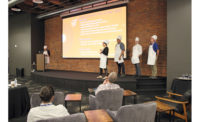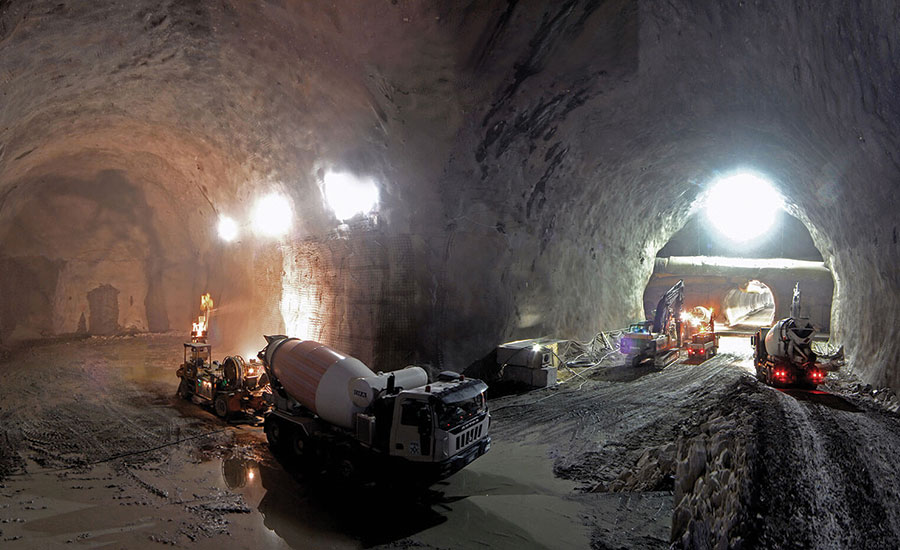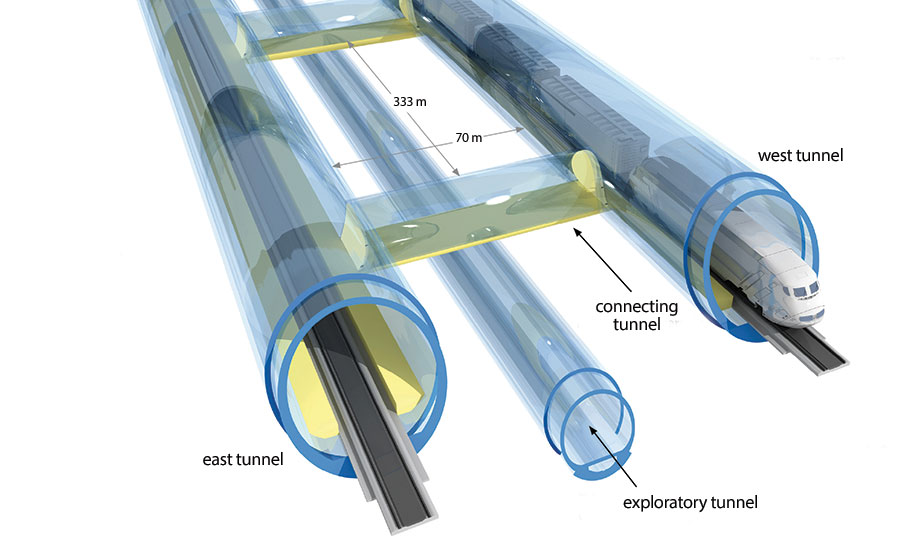Brenner Base Tunnelers Conquer Peaks and Valleys in the Alps

The Brenner Base Tunnel will pass just a few meters beneath the Isarco River. It will also pass underneath two major highways and a rail line crews cannot close during construction.
PHOTO COURTESY BBT SE

Inside the TBM, a worker guides a precast concrete lining segment into place.
PHOTO BY SCOTT BLAIR FOR ENR

Caverns and tunnel interchanges provide much-needed logistical space along the 55-km worksite.
COURTESY BBT SE

The project connects Fortezza on the Italian side with Innsbruck on the Austrian side and cuts through the Alps in a relatively straight line. An existing bypass connects the project to Tulfes. Cross tunnels every 333 m provide maintenance and emergency access. In addition, three emergency stations located approximately 20 km apart provide a safe haven for passengers in case of fire. In total, crews will bore 230 km of tunnels during the project.
TUNNEL MAP COURTESY BBT SE

The project connects Fortezza on the Italian side with Innsbruck on the Austrian side and cuts through the Alps in a relatively straight line. An existing bypass connects the project to Tulfes. Cross tunnels every 333 m provide maintenance and emergency access. In addition, three emergency stations located approximately 20 km apart provide a safe haven for passengers in case of fire. In total, crews will bore 230 km of tunnels during the project.
MAP DATA: ©2019 GOOGLE, GEOBASIS-DE/BKG

The project connects Fortezza on the Italian side with Innsbruck on the Austrian side and cuts through the Alps in a relatively straight line. An existing bypass connects the project to Tulfes. Cross tunnels every 333 m provide maintenance and emergency access. In addition, three emergency stations located approximately 20 km apart provide a safe haven for passengers in case of fire. In total, crews will bore 230 km of tunnels during the project.
SCHEMATICS COURTESY BBT SE

A plant fabricates and stores thousands of tunnel liner segments, which are shipped 10.5 km by rail to supply the TBM.
PHOTO COURTESY BBT SE

Brenner Base Tunnel passes through multiple geological zones and rock types, including hard granite and gneiss. The Periadriatic Seam (in red near the south portal of Fortezza) provided the biggest challenge to date on the project. The area of heavily fractured rock with poor geomechanical properties was too risky for TBM mining and had to be excavated using traditional methods. The twin high-speed rail tubes (image top right) enable trains to travel at up to 200 km/hour. A multipurpose exploratory tunnel in between the rail lines serves as a supply line during construction and transitions to a maintenance access and drainage line during operations.
SCHEMATICS COURTESY BBT SE

Once a year, the jobsite shuts down and the public can go deep underground to see what it’s like to work on a TBM.
PHOTO COURTESY BBT SE









A logistics tangle decades in the unraveling, the Brenner Base Tunnel project is having a banner year. Twin tunnel boring machines in May were released on their relentless journey to mine the main tunnels underneath the Alps between Austria and Italy, while a multinational crew of 2,400 workers armed with a toolkit of just about every mining technique is swarming four major worksites, including a particularly challenging area where workers must undercut a river and pass through the fast-flowing aquifer below it.
“Basically, all that’s happened until now was preparation to make things possible for what’s happening right now,” says Giorgio Malucelli, an operations manager at project owner BBT SE, a public entity established by Italy and Austria. The launch of the TBMs “is a turning point and a defining moment for us at BBT.”
When it opens in 2028, the tunnel will form the world’s longest underground rail route, serving high-speed rail passenger trains traveling up to 200 kilometers per hour, and cargo trains up to 120 km per hour, slashing the travel time over the existing overground Brenner Pass to 25 minutes from 80 minutes. An integral part of the Scandinavia-Mediterranean Rail Corridor, the tunnel flattens the transit incline from 26‰ on the existing pass to just 6.7‰ and reduces the travel distance by 20 km. The facilities are designed to be in service for 200 years.
The feasibility studies stretch back to the 1970s and ’80s, but planning began in earnest in 1994 when the European Union highlighted the route as a priority project. Ten years later, in 2004, Austria and Italy signed a treaty to build the tunnel and co-founded BBT SE to deliver the project.
Construction began in 2007, with the first exploratory bore launched in 2008 for the 55-km tunnel between Innsbruck, Austria, and Fortezza, Italy. With a link-up to the existing Innsbruck bypass, the travel length of the rail line will stretch a record-breaking 64 km, taking the mantle from the 57-km Gotthard Base Tunnel, opened in 2016 in Switzerland. But that’s only a fraction of the story. All tunnels built as part of the €8.4 billion project—including HSR, emergency, ventilation, access and exploratory—add up to around 230 km. In April, the project team crossed the milestone of 100 km of completed tunnels.
Major Fault Line
Around 70% of the main rail tunnels are yet to be excavated and lined using two pairs of 10.7-meter-dia double shield TBMs. The first pair of Herrenknecht-built machines, recently launched on the Italian (south) side, have bored 700 m and 300 m, respectively, towards their ultimate journey of approximately 12 km to the Austrian border. This TBM work comprises most of the €993-million Mules 2 and 3 lot, or contract, which was awarded in 2016 to a consortium of Astaldi, Ghella, Oberosler Cav Pietro, Cogeis and PAC.
Once lined, the parallel HSR tunnels will each have a diameter of 8.1 m and the distance between them will vary from 40 to 70 m. Side tunnels will connect the main tunnels every 333 m, to be used for maintenance access and emergencies. In between the main tunnels and about 12 m below them, a 6.8-m-dia TBM (Serena) paces about 500 m ahead of Flavia and Virginia, digging an exploratory tunnel. In addition to providing critical data regarding rock quality, the multipurpose pilot tunnel serves a central logistical role as a rail supply line for prefabricated tunnel lining segments to feed the advancing main TBMs. Upon completion, the exploratory tunnel will morph into a maintenance and drainage tunnel.
Almost a decade of prep work at the Mules site in previous contracts preceded the TBM launch, including a 10.5-km stretch of the exploratory tunnel which connects the TBMs to the concrete lining prefabrication plant.
“When dealing with a 64-km-long tunnel, logistics is the most important thing to look at before starting all the field activities,” says Raffaele Zurlo, Italian CEO of BBT SE. “If the logistical aspects are not deeply analyzed and solved, you will have problems during the tendering phase and during the construction phase, and even the completion of the project could be at risk.”
Other prep work included a 1.7-km access tunnel that descends from a staging area on the surface down about 200 m to meet the tunnel. For most of the project, this will be the only access point for workers, cars and trucks to the Mules tunnel site.
Previous phases also hollowed out 20-m-wide by 180-m-long caverns in the granite that serve various functions. For example, because the Mules design specs prohibited any surface concrete production, the batch plant is located in one of the enormous underground caverns, says Enrico Maria Pizzarotti, technical director for Pro Iter and general manager of design for Mules 2 and 3.
Early on, geotechnical engineers drilled 36,000 m of core samples to determine the rock composition throughout the Alps crossing. The work confirmed that the Brenner Base Tunnel would intersect the Periadriatic Seam, an area of heavily fractured rock with poor geomechanical properties created by the collision of the European plate and the Adriatic (African) plate.
“That major fault would’ve been too dangerous for us to drive a TBM through,” says Malucelli. As a result, the contractor used mechanical demolition and drill and blast methods. Ground consolidation methods added additional stability and mitigated risk of rock burst due to the high overburden, which in some areas of the tunnel route is more than 1.5 km thick.
The fault ended up stretching more than 1 km wide instead of the expected 700 m, but Zurlo says the team was “lucky because even though this demanding zone proved to be longer than expected, the presence of water that was supposed to be found was not found. This meant we saved time and money and worked in safer conditions.”
Once past the fault and into geologically stable rock, crews created two more large caverns and spent months assembling the 200-m-long TBMs inside.
In total, 5.5 km of tunnels have been excavated at Mules using drill and blast or machinery, including a southbound segment which the contractor proceeded with during the lengthy TBM assembly period.
At the World Tunneling Congress (WTC) in Naples, held this May, Zurlo presented a detailed analysis of the cost per cubic meter of excavation compared to rock quality experienced so far at Mules, meant to provide useful information to tunnelers but also to encourage other large-scale infrastructure project teams to provide cost data with similar unit costs so the industry will “have a panorama of what’s going on within other similar projects,” he says.
He vows that the transparent cost monitoring and analysis will continue throughout the project. The goal should not only be building and operating a rail line, he says, it “should also be to discover something new, to better understand the behavior of the rock and upgrade and improve our construction methods and organization schemes.”
Currently, the Italian side is on budget and schedule, whereas the Austrian side is pacing slightly behind schedule, Zurlo says. Flavia and Virginia should reach the border by early 2022. On the Austrian side, under a separate contract, crews prep for another pair of TBMs launching in the near future that will head south.
Four Fords at Isarco River
On the southernmost end of the Brenner Base Tunnel, crews face an even greater challenge: how to tunnel just a few meters below the rapids of an alpine river. The €303-million Isarco River Underpass lot was awarded in 2014 to a consortium of Salini Impregilo, Strabag, Consorzio Integra and Collini Lavori. Upon completion in 2022, the contract will link the tunnel with the existing Brenner line and the railway station in Fortezza.
Around 3 km of 6 km of tunneling has been completed at the site. “We have done the easiest part, which was through rock, and we were able to excavate up to 10 meters per day,” says Maurizio Ferrero, geotechnical engineer with BBT SE. For the river underpassing, productivity will slow to just a half meter per day in the alluvial soil, he says.
Just north of the river, the twin tunnels expand to their widest spaces at 275 sq m each to accommodate a bifurcation that splits off a rail interchange from the main HSR tunnels. As a result, crews must construct four tubes that will pass underneath the river as well as under two major roadways on one side of the river and an existing surface rail line on the other side.
Four enormous 25-m-deep shafts, elliptical in plan to accommodate the varying angles of the four tunnels, have been completed, two on either side of the river. They provide access for crews who will spend months preparing for large-scale ground freezing to safely construct the underpasses. The four tunnels will be between 56 m and 63 m long. Each will take four months to construct: two will be built in 2020 and the remaining two in 2021.
Originally, the design specified a cut-and-cover method of construction. But this would have required shifting the river twice and lowering the water table by 20 m. The contractor consortium proposed the ground-freezing alternative, which eliminated the environmental impact to the riverbed and associated underground aquifer, Ferrero says.
To enable ground freezing, the speed of the underground aquifer’s 16 m-per-day water flows must be slowed. “It’s a figure too high to perform the freezing treatment,” says Giovanna Cassani, technical director for Isarco designer Rocksoil. Therefore, the team will use preliminary ground consolidation by cement injection to slow the aquifer to 1.5 m to 2 m per day, to enable proper freezing, she says.
Next, 66 pipes and 88 freezing probes up to 35 m in length will be installed around the perimeter. Liquid nitrogen will drop the soil temperature to -15° C and then a brine solution will maintain the temperature during excavation. “We are basically making a giant pipe of ice and then we’re going to excavate inside,” Ferrero says. The thickness of the “pipe” on the sides and bottom will be 1 m, but because the riverbed is just 5 m to 8 m above the excavation, the top will be twice as thick.
As challenging as the river transit will be, Ferrero says he’s more concerned about tunneling under the roadways, scheduled for next year, They can’t be closed due to their major economic importance for the region. Ground consolidation will be performed not only on the sides and ceiling of the advancing tunnel, but also on the front face, to prevent it from collapsing during excavation. Crews will cycle the consolidation and excavation in 7-m increments until the section wraps up.
The steep-sided valley poses additional risks. The entire valley is devoid of direct sunlight from November until March, creating brutally cold temperatures. Because of the ever-present aquifer and river water that must be constantly pumped out of the shafts, all piping has to be heavily insulated, and concrete casting has to be carefully scheduled. Additionally, barriers have been set up to mitigate rockfalls.
Local and International Outreach
With funding coming from the European Union, Italy and Austria, project executives recognize the importance of winning public favor and communicating the message that the new rail pass will improve the economy and mobility for all Europeans. Communication methods “have to be developed comprehensively and continuously in transnational, complex infrastructural projects,” said Konrad Bergmeister, BBT SE’s Austrian CEO, during a presentation at the WTC. Over the past 12 years, he said, BBT SE has honed its communication approach, cultivated contacts both with the media and local leaders and invited the local community to visit the worksites at various tours and annual Open Tunnel Days in both Austria and Italy.
As part of that effort, BBT SE has opened three visitors centers, including BBT Tunnel World, which has drawn around 50,000 people. The two-level museum includes a demonstration mine shaft and interactive exhibits.
During the most recent Open Tunnel Day in June, the entire Mules worksite was shut down, and hundreds of hard-hatted visitors were bused deep into the tunnels and escorted onto the TBM Virginia. “The organization of this event was a real challenge. It’s not easy to open a construction site of this size to such a large audience and lead it to a TBM more than 4 km from the surface,” says Zurlo. “But we’re convinced that it is worth it, because I see a constantly growing interest in this project, which will be a reality in 10 years’ time.”













